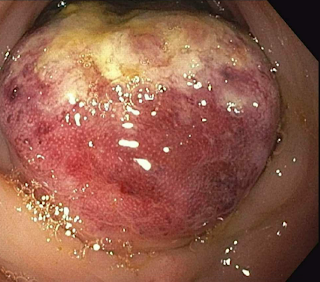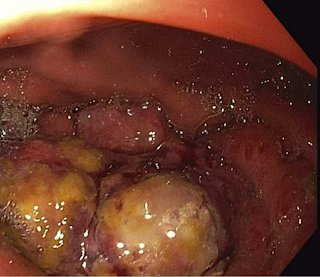Tuesday Poster Session
Category: Small Intestine
P6266 - All That Thickens Is Not Gold: Diffuse GI Seeding of ALK+ Anaplastic Large Cell Lymphoma
Tuesday, October 28, 2025
10:30 AM - 4:00 PM PDT
Location: Exhibit Hall

Swetha Kareti (she/her/hers)
Heritage College of Osteopathic Medicine, Ohio University
Broadview Heights, OH
Presenting Author(s)
Swetha Kareti, 1, Adrian S. Lindsey, MD2
1Heritage College of Osteopathic Medicine, Ohio University, Cleveland, OH; 2Case Western Reserve University / MetroHealth, Cleveland, OH
Introduction: We describe a rare presentation of diffuse seeding of ALK+ anaplastic large cell lymphoma (ALCL) throughout the GI tract. ALK is an oncogene that has been implicated in the progression of both blood and non-blood cell cancers, including non-small cell lung cancer and neuroblastoma. ALK+ ALCL is a type of peripheral T-cell lymphoma with a highly variable morphologic presentation. It ranks as the second most prevalent form of T cell lymphoma in North America, representing 6-7% of mature T-cell lymphomas.
Case Description/
Methods: A 37 year old male with a history of ALK+ ALCL status post 4 rounds of BV-CHOP was admitted for abdominal pain, nausea, vomiting and weight loss in the setting of imaging findings of new gastric wall thickening, hepatomegaly with right hepatic artery thrombosis, small volume ascites, and left sided colitis. Subsequent EGD, endoscopic ultrasound, and sigmoidoscopy showed fungating masses throughout the GI tract with biopsy proven ALK+ ALCL. He underwent ICE salvage therapy as a bridge to allotransplantation, in which repeat endoscopy after salvage therapy showed resolution of invasive masses and negative biopsies. He then underwent bone marrow transplant 3 months after his GI involvement was diagnosed.
Discussion: ALK+ ALCL usually presents as a solitary mass with nonspecific constitutional symptoms like fever, weight loss, and lymphadenopathy. In the nearly 60% of cases that have extranodal involvement, ALK+ ALCL is found in the skin, bones, and soft tissues. GI involvement is rare, and case reports usually describe nonspecific symptoms such as abdominal pain and vomiting. What characterizes this lymphoma is the presence of“hallmark cells”, which are large cells with a horseshoe-shaped nucleus in a surrounding highly eosinophilic region. The typical age of onset is 34 years old, with a male to female ratio of 1.5, and a higher incidence in African Americans and lower incidence in American Indians and Asian American/Pacific Islanders compared to White patients. Compared to other T-cell lymphomas, ALK+ ALCL has a more favorable prognosis. In an analysis of 263 patients, ALK+ ALCL had a 5 year progression-free survival of 69% and overall survival rate of 81% on a CHOP regimen. Thus, our case presentation of diffuse seeding throughout the GI tract challenges existing perceptions of the clinical manifestation of ALK+ ALCL and provides a meaningful contribution to our understanding of the pathogenesis and diagnosis of this condition.

Figure: Sigmoid mass

Figure: gastric masses
Disclosures:
Swetha Kareti indicated no relevant financial relationships.
Adrian Lindsey indicated no relevant financial relationships.
Swetha Kareti, 1, Adrian S. Lindsey, MD2. P6266 - All That Thickens Is Not Gold: Diffuse GI Seeding of ALK+ Anaplastic Large Cell Lymphoma, ACG 2025 Annual Scientific Meeting Abstracts. Phoenix, AZ: American College of Gastroenterology.
1Heritage College of Osteopathic Medicine, Ohio University, Cleveland, OH; 2Case Western Reserve University / MetroHealth, Cleveland, OH
Introduction: We describe a rare presentation of diffuse seeding of ALK+ anaplastic large cell lymphoma (ALCL) throughout the GI tract. ALK is an oncogene that has been implicated in the progression of both blood and non-blood cell cancers, including non-small cell lung cancer and neuroblastoma. ALK+ ALCL is a type of peripheral T-cell lymphoma with a highly variable morphologic presentation. It ranks as the second most prevalent form of T cell lymphoma in North America, representing 6-7% of mature T-cell lymphomas.
Case Description/
Methods: A 37 year old male with a history of ALK+ ALCL status post 4 rounds of BV-CHOP was admitted for abdominal pain, nausea, vomiting and weight loss in the setting of imaging findings of new gastric wall thickening, hepatomegaly with right hepatic artery thrombosis, small volume ascites, and left sided colitis. Subsequent EGD, endoscopic ultrasound, and sigmoidoscopy showed fungating masses throughout the GI tract with biopsy proven ALK+ ALCL. He underwent ICE salvage therapy as a bridge to allotransplantation, in which repeat endoscopy after salvage therapy showed resolution of invasive masses and negative biopsies. He then underwent bone marrow transplant 3 months after his GI involvement was diagnosed.
Discussion: ALK+ ALCL usually presents as a solitary mass with nonspecific constitutional symptoms like fever, weight loss, and lymphadenopathy. In the nearly 60% of cases that have extranodal involvement, ALK+ ALCL is found in the skin, bones, and soft tissues. GI involvement is rare, and case reports usually describe nonspecific symptoms such as abdominal pain and vomiting. What characterizes this lymphoma is the presence of“hallmark cells”, which are large cells with a horseshoe-shaped nucleus in a surrounding highly eosinophilic region. The typical age of onset is 34 years old, with a male to female ratio of 1.5, and a higher incidence in African Americans and lower incidence in American Indians and Asian American/Pacific Islanders compared to White patients. Compared to other T-cell lymphomas, ALK+ ALCL has a more favorable prognosis. In an analysis of 263 patients, ALK+ ALCL had a 5 year progression-free survival of 69% and overall survival rate of 81% on a CHOP regimen. Thus, our case presentation of diffuse seeding throughout the GI tract challenges existing perceptions of the clinical manifestation of ALK+ ALCL and provides a meaningful contribution to our understanding of the pathogenesis and diagnosis of this condition.

Figure: Sigmoid mass

Figure: gastric masses
Disclosures:
Swetha Kareti indicated no relevant financial relationships.
Adrian Lindsey indicated no relevant financial relationships.
Swetha Kareti, 1, Adrian S. Lindsey, MD2. P6266 - All That Thickens Is Not Gold: Diffuse GI Seeding of ALK+ Anaplastic Large Cell Lymphoma, ACG 2025 Annual Scientific Meeting Abstracts. Phoenix, AZ: American College of Gastroenterology.
